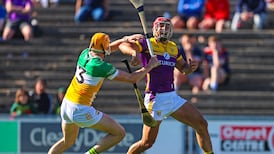In our series of articles from the GAA Museum, we look at the Amateurism v Professionalism debate, which reached a head at the annual Congress which banned “collective training”
IN 2008, the GAA Museum Archive acquired the John J Higgins Collection, documents which detail how the Laois County Board prepared for the 1914 and 1915 All-Ireland Hurling Finals.
The documents show that in March 1914 a training fund sub-committee was established. When Laois beat Kilkenny in the Leinster Final (and thus qualified for the All-Ireland Final), a renewed fund-raising drive was initiated by the sub-committee.
A circular was distributed throughout the county explaining that training for the Leinster Championship had been carried out at the personal expense of the members of the team, many of whom had to provide substitutes to fill their places of employment during the frequent training sessions. The circular appealed to people to contribute to the fund, as “It would be too much for the players to bear the expenses of the extra special course of training which will be necessary for the playing of the All-Ireland Final”.
In February 1953, nearly 40 years later, a committee was established by the governing body of the GAA, the Central Council, to determine whether paying compensation to players was consistent with the amateur ethos of the association. Nine months later, in November 1953, the committee reported back that, in its view, “full-time training, whether or not it involves the payment to trainees in kind or otherwise, is inconsistent with the amateur status” of the association and should be prohibited.
Central Council agreed that only Congress could adopt or reject the committee’s findings.
The first five motions on the agenda for the 1954 Congress all related to “collective” or “full-time” training. Three of the motions called for this type of training to be prohibited, the remaining two called for it to be allowed.
Before debating the motions, GAA president Michael O’Donoghue carefully explained to delegates that “full-time training” or “collective training” was the type of training that consists of bringing “a whole team away from their ordinary work or employment . . . keeping them for a period of time in a hotel or camp . . . then paying these trainees in cash or in kind for the period”.
The first motion on the agenda, calling for collective training to be prohibited, was formally moved and seconded. The question now before Congress was, did collective training equate to professionalism?
A lengthy, and at times personal, debate followed.
One issue debated among the delegates was whether collective training had brought benefits to the games themselves. One D de Burca argued that the fitness of players and the standard of the games was the same now (1954) as it had been before collective training became common place. Daniel Ó Ruairc, a future president of the association, took the opposite view and suggested that if collective training were prohibited spectators would soon be coming to Croke Park to watch “teams that are composed of players that have to lie down every few minutes”. Attendance figures, and gate receipts, would drop dramatically, he argued. Spectators would flock to other, professional sports for entertainment.
He also intimated that in Roscommon collective training, which had directly resulted in the county winning two All-Ireland Championships, was funded by collections at chapel gates. Ó Ruairc concluded by saying, “If the GAA are going to turn professional on all they get at chapel gates, I wish them luck”.
C Ó Murchadha raised the point that when his county, Cork, availed of collective training on one occasion, the financial aspect of the training caused disharmony among the players themselves with some men receiving more in compensation than others. There was also the issue of players directly profiting from the arrangement, with Ó Murchadha stating: “We had players who earned a certain amount demanding more and getting it or else they would not come until they got it”.
Delegates from Donegal and Kerry argued that the landscape and size of a county must be taken into account. Some counties were large, had a sparse population and only limited public transport. It would be too much, delegates argued, to expect farmers and labourers to make daily round trips to training in advance of a match. The only option to county boards in such counties was to bring all the men together for a period of three to four days for intensive training. If team members were going to be asked, or expected, to pay their own travelling, accommodation, subsistence and “substitute workers fees”, then a significant amount would drop out of Gaelic games altogether – not out of spite but out of economic necessity.
At one stage in the debate, P Ó Maoileanaigh read the definition of an amateur from both the Encyclopaedia Americana and the Encyclopaedia Britannica, before reading the rules of the American Amateur Athletic Association which defined an amateur as “one who does not receive, directly or indirectly, any hotel, travelling or other tokens in respect of athletic participation, including training”. Did this now mean that members travelling on the annual trip to New York would have to pay their own travelling and expenses? What of delegates who attended, and claimed expenses for, county, provincial and annual congresses?
The day before the motion, Jim Phelan wrote in The Times Pictorial, “This debate should be a marathon”, and his prediction proved correct. After 90 minutes one delegate appealed to Congress to vote on the motion, yet it continued for some time. When the motion was finally put to the Congress, 95 delegates voted to ban collective training, 56 voted that it should be allowed.
www.gaa.ie/museum for details on a GAA Museum/ Irish TimesTransition Year Essay Competition.









